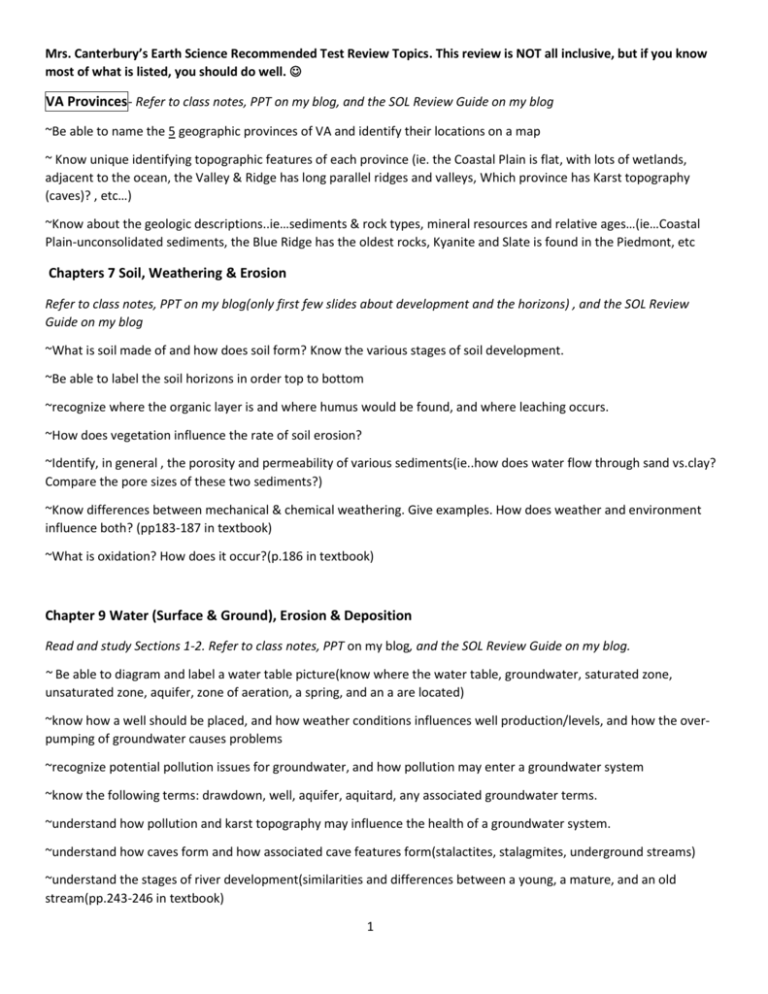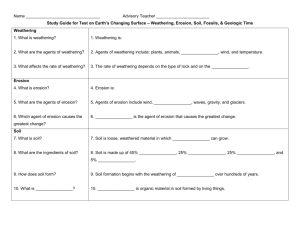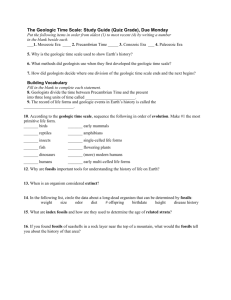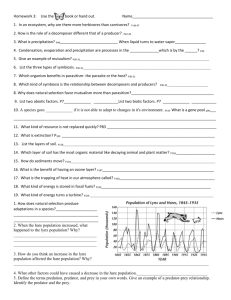Mrs. Canterbury`s Earth Science Recommended Test Review Topics
advertisement

Mrs. Canterbury’s Earth Science Recommended Test Review Topics. This review is NOT all inclusive, but if you know most of what is listed, you should do well. VA Provinces - Refer to class notes, PPT on my blog, and the SOL Review Guide on my blog ~Be able to name the 5 geographic provinces of VA and identify their locations on a map ~ Know unique identifying topographic features of each province (ie. the Coastal Plain is flat, with lots of wetlands, adjacent to the ocean, the Valley & Ridge has long parallel ridges and valleys, Which province has Karst topography (caves)? , etc…) ~Know about the geologic descriptions..ie…sediments & rock types, mineral resources and relative ages…(ie…Coastal Plain-unconsolidated sediments, the Blue Ridge has the oldest rocks, Kyanite and Slate is found in the Piedmont, etc Chapters 7 Soil, Weathering & Erosion Refer to class notes, PPT on my blog(only first few slides about development and the horizons) , and the SOL Review Guide on my blog ~What is soil made of and how does soil form? Know the various stages of soil development. ~Be able to label the soil horizons in order top to bottom ~recognize where the organic layer is and where humus would be found, and where leaching occurs. ~How does vegetation influence the rate of soil erosion? ~Identify, in general , the porosity and permeability of various sediments(ie..how does water flow through sand vs.clay? Compare the pore sizes of these two sediments?) ~Know differences between mechanical & chemical weathering. Give examples. How does weather and environment influence both? (pp183-187 in textbook) ~What is oxidation? How does it occur?(p.186 in textbook) Chapter 9 Water (Surface & Ground), Erosion & Deposition Read and study Sections 1-2. Refer to class notes, PPT on my blog, and the SOL Review Guide on my blog. ~ Be able to diagram and label a water table picture(know where the water table, groundwater, saturated zone, unsaturated zone, aquifer, zone of aeration, a spring, and an a are located) ~know how a well should be placed, and how weather conditions influences well production/levels, and how the overpumping of groundwater causes problems ~recognize potential pollution issues for groundwater, and how pollution may enter a groundwater system ~know the following terms: drawdown, well, aquifer, aquitard, any associated groundwater terms. ~understand how pollution and karst topography may influence the health of a groundwater system. ~understand how caves form and how associated cave features form(stalactites, stalagmites, underground streams) ~understand the stages of river development(similarities and differences between a young, a mature, and an old stream(pp.243-246 in textbook) 1 ~ know the following terms: runoff, stream erosion(p.241), deposition, delta, alluvial fan,permeable, impermeable, porosity ***Additional topics: Know what contact metamorphism is and where it occurs( edges of igneous intrusions) How to calculate Density, & Volume (Are you singing the DMV song yet?) Review of how the three major rock types form Principles of Scientific Investigation(manipulation of variables, how to set up an experiment, proper scientific technique in the lab(ie..how do you read a liquid level in a cylinder?) Chapter 13- Clue’s to Earth’s Past- Fossils & Relative and Absolute Dating ~ Know how fossils form(ie..conditions needed, what makes a fossil ,etc.) ~Rock type fossils are found in the most ~Understand that fossils can help us to understand the environment and life of the past ~Types of fossils ~ Know what an index fossil is and what makes a fossil an index fossil ~Know how to interpret a geologic cross-section, and be able to give a geologic history of it. ~understand and apply the following laws/principles: Superpositioning, Original Horizontality, Cross-Cutting relationships, Uniformitarianism, Catastrophism ~Half-life definition and how to calculate age, and determine the age of a fossil or rock, and interpret a halflife chart ~The difference between relative and absolute dating(radiometric dating) ~Know what an unconformity is and the 3 types (p.372) ~Know what folded rock layers look like and how to determine the youngest vs. the oldest(p.371) Chapter 14- Geologic Time ~Understand the major divisions of the Geologic Time Chart, and what caused the ending and beginnings of the various eras& eons (p. 393, but you DO NOT need to memorize the chart, just know the significance and names of major divisions) ~Know the major events and labels of the various times(ie. The Age of the Reptiles, the time when life exploded, when modern man evolved, etc.) ~Know the which time is the longest, which is the shortest (Eon, Era, Period, Epoch) ~Know that Earth is believed to be 4.6 billion yrs old ~Know why life began to evolve rapidly(cyanobacteria produces oxygen 2








